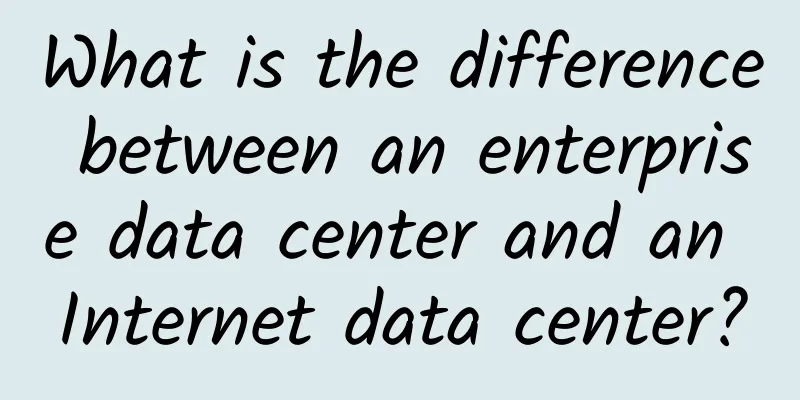What is the difference between an enterprise data center and an Internet data center?

|
Data centers are currently the hottest investment industry market in the IT field. It is estimated that the size of this market (in China) will reach approximately US$15.7 billion in 2015. Looking at the global data center market, the growth rate is also obvious. Such a large market size has also spawned many market opportunities, attracting many IT giants and manufacturers, making this market extremely lively. This can be seen from the second quarter financial report of Cisco, an important player in the data center market. The general network business grew by 11%, but the data center business grew by 40%. The growth rate of the data center market was much higher than that of other markets. The quarterly financial reports of other manufacturers were similar. The data center is the fastest growing market segment. Manufacturers that had early layouts in the data center market have now achieved rapid growth. As the total market size of data centers continues to expand, almost all manufacturers participating in the data center market have achieved more market growth. Today, the number of data centers in China alone will reach 1 million, and is still increasing. As the market size expands, the data center market has been subdivided into different types of data centers. For example, it can be divided by scale, by user, or by green level. This article mainly talks about how to classify data centers from a market perspective. Data centers can be divided into enterprise data centers and Internet data centers according to the different service objects. An enterprise data center is a data center built and owned by an enterprise or organization to serve the business of the enterprise or organization itself. It provides information services such as data processing and data access to enterprises, customers and partners. The servers of an enterprise data center can be owned by the enterprise itself or rented from a telecommunications-grade computer room. The operation and maintenance methods are also very flexible. The operation and maintenance can be undertaken by the enterprise's internal IT department or outsourced to a professional IT company. An Internet data center is owned by a service provider and provides paid information services to customers through the Internet. Compared with enterprise data centers, Internet data centers serve a wider range of objects, are larger in scale, and have more professional equipment and management. Internet data centers are closely related to our daily work and life, and their service objects are mainly individuals. From the characteristics of the two types of data centers, it can be seen that Internet data centers are larger in scale, generally super-large-scale data centers, and have hundreds of thousands of servers, which are not comparable to ordinary enterprise data centers. Due to the vigorous development of the Internet, the technology of Internet data centers has been updated faster and faster. A series of new technologies such as cloud computing, big data, virtualization, and software-defined data centers are aimed at the pain points of Internet data centers to solve the various problems faced by Internet data centers after they become larger, which has also spawned many market opportunities. Obviously, only in the Internet data center market can more enterprises have opportunities. Enterprise data centers are still firmly monopolized by data center giants such as Cisco, HP, IBM, and Emerson. It is difficult for emerging innovative enterprises to find opportunities, but it is different in the Internet data center market. These data centers like to take risks, are willing to accept new things, and have the courage to innovate. Therefore, they are willing to try better technologies and more energy-saving solutions. Although the risks are great, only in this way can they have the opportunity to surpass others. In today's extremely fierce Internet competition, only by having technological innovations that others cannot do can we defeat others. Internet data center technology is updated very quickly, and disappears even faster. If you cannot make good use of these new technologies, you will fall behind others if you take a detour. Compared with enterprise data centers, Internet data centers have issued detailed industry standards and graded data centers. The China Communications Standards Association has issued Internet data center technology and classification standards, as well as YD/T2543-2013 Telecom Internet Data Center Energy Consumption Evaluation Method, YDB116-2012 Internet Data Center Security Protection Requirements, and YDB117-2012 Internet Data Center Security Protection Detection Requirements. Detailed industry standards also provide a reference for the development of Internet data centers, allowing them to develop in a formal and orderly manner. Nowadays, all new hot information technologies are based on Internet data centers. Internet data centers are certainly important. Innovation is everywhere here. They are the best experimental fields for new technologies and the future of data centers. However, compared with enterprise data centers, the number of Internet data centers is not large. There are nearly 1 million data centers in China, while there are less than 10,000 Internet data centers. Most of the super-large/large data centers are basically from Internet data centers. Simply speaking, Internet data centers have an advantage in scale, while enterprise data centers have an absolute advantage in number. Traditional data center technologies are still important and are playing an important role in enterprise data centers. They will not be eliminated for quite a long time. Moreover, many new technologies of Internet data centers can only show their advantages in large-scale business deployment. If they are deployed in enterprise data centers, they will not get good results. Therefore, some traditional data center technologies will never be eliminated in enterprise data centers, but will still be developed and improved. Internet data centers and enterprise data centers represent two schools of thought: new and old technologies. In the short term, both will exist for a long time. Each technology has its own advantages, and neither can replace the other. While maintaining their leading edge in enterprise data centers, traditional data center giants are also competing with numerous innovative companies for market opportunities in Internet data centers. |
<<: Analysis of the Four Major Disaster Recovery Technologies in Data Centers
>>: Cloud Data Center in the "Internet +" Era
Recommend
How does CDN acceleration work? What are its benefits?
Many website operators believe in a principle tha...
Huawei HC releases AIOps series cloud services to enable intelligent transformation of new infrastructure operations and maintenance
[51CTO.com original article] On September 25, 202...
A topic worth pondering: Will the birth of Wi-Fi 7 replace 5G networks?
In recent years, wireless technology has develop...
Ruijie Networks launches a new solution for Ethernet all-optical network construction to tailor campus networks for multiple industries
In recent years, the trend of "optical fiber...
5G promotes the transformation and upgrading of operators and expands new forms and models of information consumption
Recently, the website of the Central Commission f...
Catch it all - Webpack project packaging 1
[[427986]] This article is reprinted from the WeC...
Sharktech: 50% off on Los Angeles high-security VPS, 2GB RAM/30GB SSD/4TB bandwidth starting at $6.57 per month
Sharktech Shark Data Center VPS 50% discount code...
Home broadband can also be wirelessly accessed. What are the benefits for IoT?
People are looking forward to a lower-priced broa...
Huawei Network Energy "Innovation" on the Road
[51CTO.com original article] Introduction: "...
Why is it necessary to change the RAN architecture?
First, we need to know why we need to evolve from...
MIIT talks about 6G: Breakthroughs in key core technologies are needed
According to the news from the Ministry of Indust...
Morgan Digital still chooses Feiyuxing Wireless to build branch network
In March this year, the headquarters building of ...
CloudCone Easter Sale: Los Angeles KVM Annual Payment Starting at $12.95
CloudCone's Easter promotion started on the m...
Friendhosting 50% off promotion, VPS half-year payment starts from 7.5 euros
Friendhosting has launched a promotion for "...









